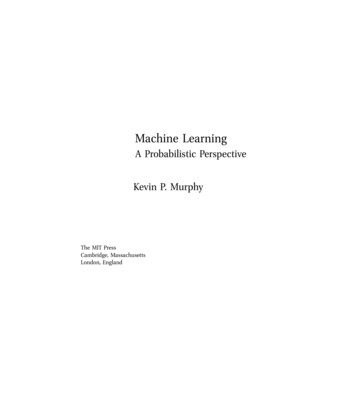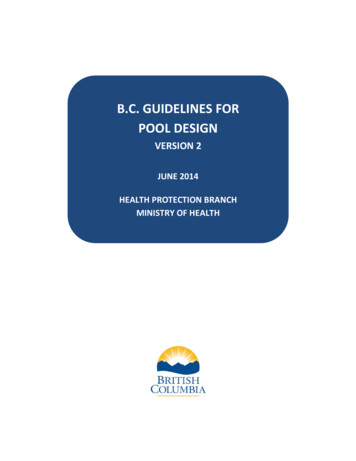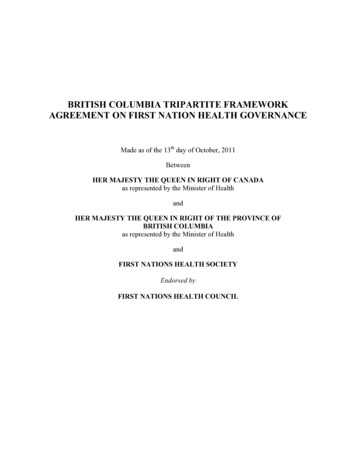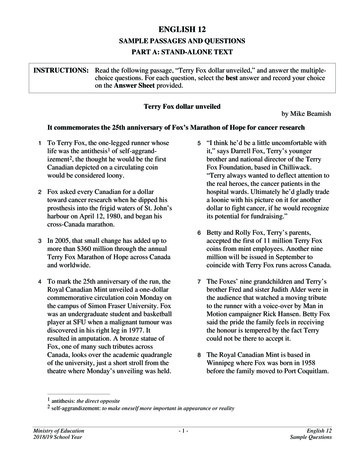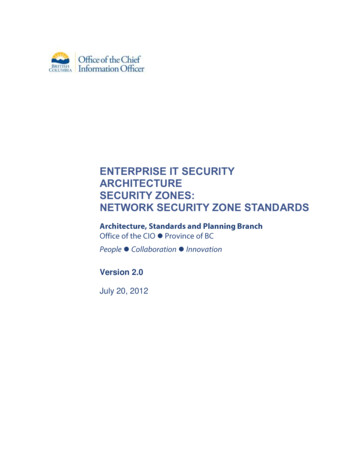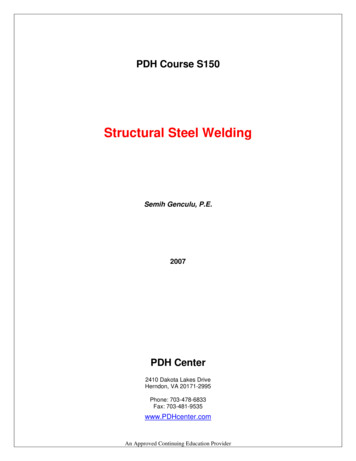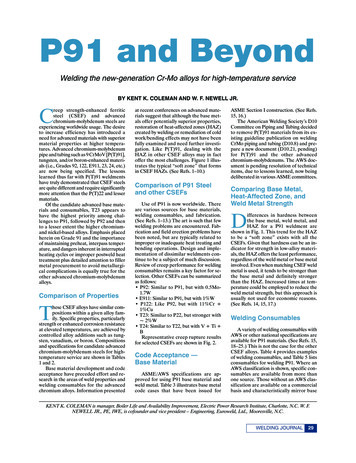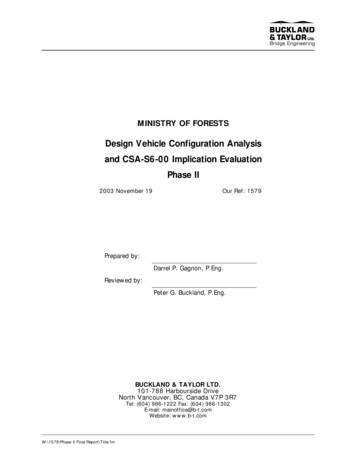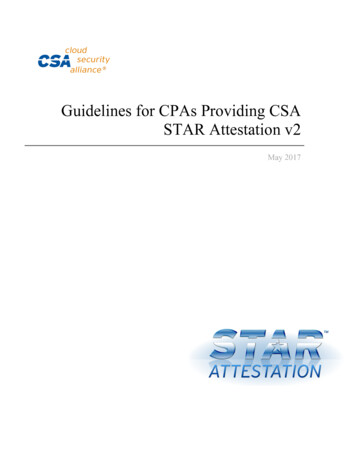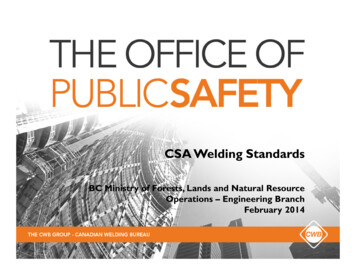
Transcription
CSA Welding StandardsBC Ministry of Forests, Lands and Natural ResourceOperations – Engineering BranchFebruary 2014
Although due care has been taken in the preparation ofthis presentation, neither the CWB nor any contributingauthor can accept any liability arising from the use ormisuse of any information contained herein or for anyerrors that may be contained in the presentation.Information is presented for educational purposes andshould not be used for design, material selection,procedure selection or similar purposes withoutindependent verification. Where reference to otherdocuments, such as codes and standards, is madereaders are encouraged to consult the original sourcesin detail.
Agenda An overview of Welding Standards What is the CWB and OPS? CSA Certification Programs Companies, Type of Divisions Inspectors and Inspection Organizations Electrodes & Consumables CSA Fabrication Standards CSA Standard for Bridges and its connection to weldingcertification Electrodes, workmanship and technique Example of poor welds / defects Q&A
What Makes a “Good” Weld?IndustrybestpracticeA 2nd lookTechnicalsupportRight materialsGoodWeldSafe workpractices
Welding StandardsLloydsCSADNVAWSWeldingCodes &StandardsAPIISOASMEASNZJIS
CSA Welding Standards The Canadian Standards Association (CSA) has a full suite ofstandards related to welding. These include standards for: Qualifying welders & proceduresWelded fabrication & techniquesWeld designWelding consumablesWelding inspectionWelding safety In addition, CSA has several standards that complement thewelding standards: Steel & aluminum design Material designations / specifications
CSA Welding Standards Qualifying welders & procedures CSA W47.1 “Certification of Companies for the fusion welding of steel” CSA W47.2 “Certification of Companies for the fusion welding ofaluminum” CSA W186 “Welding of reinforcing bars” CSA W55.3 “Certification of companies for resistance welding of steel andaluminum” Welded fabrication & techniques / Weld Design CSA W59 “Welded steel construction” CSA W59.2 “Welded aluminum construction”
CSA Welding Standards Welding consumables CSA W48 “Filler Metals and Allied Materials for Metal Arc Welding” Welding inspection CSA W178.1 “Certification of Welding Inspection Organizations” CSA W187.2 “Certification of Welding Inspectors” Welding safety CSA W117.2 “Safety in welding, cutting, and allied processes”
CWB: History Created by CSA in 1947, the CWB provided, and continues toprovide, stability in an industry where local, regional and industryrules made the safe and constant use of welding difficult. Under the Canadian Standards Association, the CWB administeredthe CSA company certification and welder qualification schemeacross Canada as part of the National Building Code. In the early 1990’s The CWB was spun off as a not-for-profitcompany -The CWB Group. Since that time the recognition and demand for weldingcertification in Canada has grown steadilyThe key role :The protection of public safety
CWB: An Overview Administrator of CSA and other standardsA third party certification and auditing service providerA Standards Council of Canada (SCC) accredited certification bodyA private independent not-for-profit corporationFunded solely by industry from fees charged
CWB: An Overview CWB Group – Canada’s largest welding services provider Welding certification & services to over 7000 companies world-wideConduct over 11,000 field site audits annuallyWitness approx. 90,000 on-site welder qualification test plates annuallyApprove over 33,000 welding procedures annuallyResponsible for the creation and administration of exams for all WeldingSupervisors, Visual Inspectors and Welding Engineers within CanadaProvide Welder Supervisor and Visual Inspector training servicesProvide non-destructive examination (NDE) training servicesDeliver ISO and other quality systems registration/assessment servicesRepresent over 40,000 members through our membership association
CWB: An Overview Internationally, the CWB represents the International Institute ofWelding (IIW) as the: Authorized National Body (ANB) in Canada Authorized National Body for Company Certification (ANBCC) inCanada We are Welding! 160 staff in Canada and the world 70% of staff are technical – most welding inspectors, weldingtechnologists or welding engineers Provides services in over 35 countries
CWB Office of Public Safety: AnOverview The Office of Public Safety was created to educate and advocate forboth public safety and the Canadian industry while ensuring theCanadian Welding Bureau’s accreditations are maintained andexecuted to the highest standards The CWB Office of Public Safety is also a resource for BuildingOfficials, Owners, Specifiers and Industry to better understandstandards related to welding and construction and how effectiveimplementation of these standards can assist the industry tobecome more competitive, improve quality reduce risk and maintainpublic safetywww.weldquality.org
CSA Certification Programs CSA certification programs are in place for: Fabricators Inspection Organizations / Inspectors Electrodes & Filler Metals Common to all programs: Independent verification of compliance Demonstration of competence and/or technical compliance Continual monitoring of compliance Key Benefits: Improved quality / Reduction of risk Level playing field for industry Independent oversight
CSA Certification: Drivers CSA certification programs are driven by: Mandatory requirements in design and product standardsOwner specificationsThe need demonstrate due diligence / reduce riskThe desire to improve quality / lower rework
CSA Certification: Fabricators There are 4 available programs for fabricators: CSA W47.1 “Certification of Companies for the fusion welding of steel” CSA W47.2 “Certification of Companies for the fusion welding ofaluminum” CSA W186 “Welding of reinforcing bars for reinforced concreteconstruction” CSA W55.3 “Certification of companies for resistance welding of steel andaluminum”
CSA Certification: Fabricators There are 4 key elements to a fabricator certification program:1.2.3.4.Qualified weldersQualified welding supervisor (s)Qualified welding engineer(s)Accepted welding procedures In practical terms, this means that a welding fabricator must have: Competent people making the welds, who are Following proven and documented “recipes”, in a shop Overseen by competent “bosses” When all three are in place, high quality welds will result Certification ensures these key elements are in place and working
CSA W47.1: Steel FabricatorsCSA W47.2: Aluminum Fabricators Fabricators can be certified to 1 of 3 “divisions”.Division 3Division 2Division 1Qualified WeldersYesYesYesQualified WeldingSupervisor(s)YesYesYesQualified WeldingEngineer(s)NoYes – RetainedYes - EmployedAccepted WeldingProceduresYesYesYes Unlike W47.1 and W47.2, W186 requires all fabricators to becertified in either Division 1 or Division 2.
CSA W47.1 & CSA W47.2 Fabricators must define the “scope” of their certification Like any quality system, the work that falls within the control of thesystem must be clear to both the employees of the organization, theindependent certification body and the customers This is done through a statement on a Fabricator’s certificate andmade available to the public Examples: “Welding, fabrication, manufacturing for bridges.” “Field welding fabrication, repairs and maintenance for the highways and bridges.” “Welding and fabrication of steel buildings including miscellaneous work likehandrail, stairs and platforms”
Requirement #1:Qualified Welders Must pass a practical test For joint, positions and processes used Witnessed by the CWB Issued a Welder Card, or “Ticket” Valid for the certified company named on the ticket Tickets transferable between certified companies Use of Ticket Valid only while employed by a CWB certified company Normally, valid only for 2 years
Requirement #1:Qualified Welders Welders are tested for specific: Welding processes SMAW, FCAW, GMAW Electrode type Steel, stainless, aluminum Welding position Flat, horizontal, vertical, overhead Welding joints / types Fillets, grooves, backing/no backing, plate, tubular
Requirement #1:Qualified Welders Welders test are evaluated by either:1. Destructive tests Bends, fracture, macro-etch2. Non-destructive tests Radiography
Requirement #1:Qualified Welders
Requirement #2:Qualified Welding Supervisor(s) Employ at least one Welding Supervisor Must demonstrate: Minimum education/knowledge drawings, welding symbols, knowledge of weld faults, quality control,inspection methods and the company’s welding procedures &equipment welding codes and standards Examinations are requiredMinimum experience 5 years of welding-related experience pertinent to the company’s typeof operations Key roles: To ensure that welders are qualified To ensure that welding procedures To ensure visual weld quality requirements
Requirement #3:Qualified Welding Engineer(s) Employ/Retain at least one Welding Engineer (Div. 1 or 2 only) Must demonstrate: Minimum education/knowledge Steel / aluminum, welding fundamentals, welding metallurgy, and weldingprocedures and practice. Welding codes and standards Examinations are requiredMinimum experience 5 years of welding-related experience Key roles: Development of new welding procedures Documentation related to welding procedures Periodic review of overall welding operations
Requirement #4:Qualified Welding Procedures A document of welding details & parameters; a “recipe” for welding Covers items such as: base materialfiller materials / electrodesjoint details: thickness, preparation, positionwelding parameters, pass/layer sequencepreheat Are independently reviewed and accepted by the CWB against therequirements of the certification standard and governing standards In some cases are deemed to be “pre-qualified”, i.e. no qualificationtesting is required
Requirement #4:Qualified Welding Procedures
Maintaining CWB Certification Certification is an ongoing process To maintain certification, companies must:Qualify new & check test existing welders every 2 yearsSubmit new or revised welding procedures, as requiredContinually verify visual acceptance of welded product(s)Ensure any CWB “scope” work subcontracted to a CWB certifiedcompany The CWB audits each company every 6 months Costs: 1500 - 1900/ year
How can I verify CWB Certification? Verify company status on CWB website www.cwbweb.orgAsk fabricator for current Letter of Validation Annual letter given to certified clients Verify dates Verify scope of operations.Call the CWB 1-800-844-6790
How can I verify CWB Certification?
CSA Certification:Welding Inspection There are 2 available programs related to inspection: CSA W178.1 “Certification of Welding Inspection Organizations” CSA W178.2 “Certification of Welding Inspectors”
CSA Certification:Welding Inspection CSA W178.1 “Certification of Welding Inspection Organizations” Covers organizations that provide welding inspection services Key requirements: Inspection must be conducted by competent, certified individuals Both visual welding inspectors and NDE (e.g. ultrasonic,radiography personnel)Inspection operations must be overseen by competent, qualifiedindividual(s) (known as the Welding Inspector Supervisor)Inspection must follow inspection procedures for each of the productcategories included in the scope of operations. independently reviewed and approved by the CWBFormal inspection reports must be documentedMust demonstrate ongoing compliance annual audit by the CWB.
CSA Certification:Welding Inspection Welding Inspection Organizations must define their scope of workby defining:1. The inspection methods that they useVisual (VT)Radiographic (RT)Ultrasonic (UT)Magnetic Particle (MPI)Liquid Penetrant (LPI)Eddy Current (EC)MechanicalMetallographic2. The product categories which they inspectBuildings & BridgesPipelinesStorage TanksIndustrial PipeMobile Drilling UnitsSteel Fixed Offshore StructuresIndustrial Structures,Machinery, CranesPressure Vessels, HeatExchangers, BoilersShips & Floating Marine Structures The competence of their staff (i.e. inspectors) and theirprocedures are assessed against this scope
CSA Certification:Welding Inspection CSA W178.2 “Certification of Welding Inspectors” Covers individuals that conduct welding inspection Key requirements: Individuals must meet a minimum number of years of experienceIndividuals must demonstrate specific technical knowledge: welding fundamentals, welding inspection, and weldingmetallurgy practical evaluation techniques written and practical examinationsIndividuals must meet minimum vision requirementsMust demonstrate ongoing compliance involvement in welding inspection activities understanding of current product standard requirements ability to meet vision requirements
CSA Certification:Welding Inspection Certification is available in one of 3 levels: Level 1 (must work under Level 2’s or 3’s) Level 2 Level 3 All levels can conduct inspection and document results Level 2 is considered the first level where fully independent workcan be done At Level 3, additional duties are typically added such as: interpreting specifications and codes, preparing welding inspectionprocedures, and implementing quality assurance and control programs reviewing contractors' inspection and test plans
CSA Certification:Electrodes & Filler Metals Electrodes / filler metals are critical components in making a weld CSA W48 “Filler Metals and Allied Materials for Metal Arc Welding”provides the following requirements: Qua
CSA W47.1: Steel Fabricators CSA W47.2: Aluminum Fabricators Fabricators can be certified to 1 of 3 “divisions”. Unlike W47.1 and W47.2, W186 requires all fabricators to be certified in either Division 1 or Division 2. Division 3 Division2 Division 1 Qualified Welders Yes Yes Yes Qualified Welding Supervisor(s) Yes Yes Yes Qualified Welding
